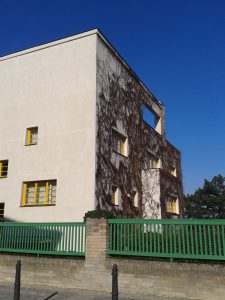The Müller Villa and the innovative design of architect Adolf Loos
By Tracy A. Burns
A prime example of modern architecture
 Built by Viennese Adolf Loos and Czech Karel Lhota from 1928 to 1930 for František Müller and his family, the Neo-Classicist Müller Villa is a prime example of modern architecture in the Czech lands during the interwar years. Located on Nad Hradním vodovojem Street in the Střešovice quarter of Prague 6, the villa features a cube-like form, a significant characteristic of Loos’ style called the Raumplan. Loos employs bright colors and bizarre color schemes, and each room is on a separate floor. Loos also utilized expensive materials for the furnishings.
Built by Viennese Adolf Loos and Czech Karel Lhota from 1928 to 1930 for František Müller and his family, the Neo-Classicist Müller Villa is a prime example of modern architecture in the Czech lands during the interwar years. Located on Nad Hradním vodovojem Street in the Střešovice quarter of Prague 6, the villa features a cube-like form, a significant characteristic of Loos’ style called the Raumplan. Loos employs bright colors and bizarre color schemes, and each room is on a separate floor. Loos also utilized expensive materials for the furnishings.
The villa’s history through 1968
The half-German family was permitted to reside in the villa during the Nazi Occupation. However, fate under Communist rule was not so kind to the Müllers. During 1951, Mr. Müller died tragically while stoking the boiler. Under Communist rule, the villa was used as the offices for the Institute of Marxist-Leninism. The architectural gem fell into disrepair. The daughter, Eva, emigrated. Mrs. Müller was allowed to stay in two small rooms after her husband’s death. She died in 1968.
The villa after the Velvet Revolution
After democracy came to Czechoslovakia in 1989, the villa was returned to Eva, who sold it to the City of Prague. The Müller Villa was designated as a cultural monument in Czechoslovakia during 1968 and as a National Monument of the Czech Republic in 1995. Now it looks as it did in 1930. It has been open to the public since 2000.
The living room
The living room is a light and open space, divided into three sections. Pillars stand where a wall would normally be. The two side areas are filled with mostly low furniture while the central part once served as a dance floor. Loos’ penchant for unique color combinations is exemplified in the green, purple and pink furnishings. Landscapes from the 19th and 20th centuries adorn a wall. Two fish tanks also stand out in the space. The fireplace boasts a Neo-Classical relief.
The dining room
The dining room, however, is dark and low, measuring less than three meters in height. While the table is prepared for six guests, it can be extended to seat 18 people. Paintings by Neo-Romantic Czech artist Jan Preisler adorn a wall. Plant decoration adds to the room’s charm.
The library
The library was also the place where business meetings were held. There was a projection screen on the wall, also adorned with a splendid Dutch tile stove. Above a decorative fireplace is large mirror.
The master bedroom and the dressing rooms
The master bedroom is situated between two dressing rooms and is decorated with furniture made from pear wood. From the window there is a superb rooftop-dotted view of Prague. The French wallpaper, curtain and bedspread sport the same pattern: pictures show various sea-related scenes, such as people lugging boats into the water while others are rowing. The two dressing rooms, designed by Brno-based Czech architect Jan Vaněk, include moveable drawers. The Ladies’ Dressing Room has a closet for hats and a desk with a collapsible mirror.
The children’s room
The children’s room has three beds – one for the child and another for the nanny. The third, isolated behind a curtain, is where Eva slept when she was sick. In this room Loos’ bright color scheme is evident: he utilizes yellows, blues, greens and reds. The room is divided into two parts, one section for sleeping and the other for playing.
The Summer Dining Room
The Summer Dining Room favors a Japanese style. It has green and black furnishings. A Japanese lantern light hangs above a table in the center of the room. From the large window, there is a superb view of the terrace and Prague Castle.
The Ladies’ Boudoir and the kitchen
The window in the Ladies’ Boudoir, a space divided into lower and upper parts, slides up and down like windows on a train. The furniture and paneling in this room are made of rare lemonwood. In the kitchen, the windows are very high because Loos thought women should not be looking out the window while cooking.
Other spaces
There is also an exhibition space concerning the Müllers’ lives and the restoration work on the villa. Mrs. Müller’s Praga car is on display in the garage. Visitors tour the basement rooms, too.
A significant architectural achievement
Loos’ trademarks of economy and efficiency are visible in the villa’s Neo-Classicist design, a style distinguished by simplicity and symmetry. Visitors become familiar with Loos’ innovative style, which played such a significant role in modern architecture. Reservations must be made in advance. Some tours are in English.




